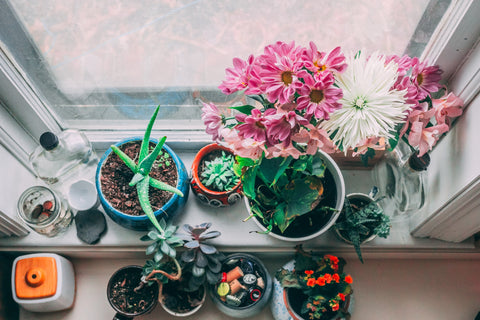
When it comes to keeping the air in your house fresh, sometimes going all-natural is a helpful option. Here are a few plants that use old-fashioned photosynthesis to keep you breathing clean air every day.
Anyone who’s ever had to step outside for some fresh air can tell you that the air in our buildings and homes isn’t always ideal. Whether it’s because of poor ventilation systems, pets, or even an excess of dirty laundry, it’s easy for these enclosed spaces to get a little stuffy.
Sure, scented candles and air fresheners are quick and easy ways to give your living space the illusion of freshness, but the goal should be truly clean air. Although there are a range of effective air-filtering products, sometimes all-natural solutions are the secret remedies.
The NASA Clean Air Study
Published in 1989, the NASA Clean Air Study was conducted to investigate how various types of plants can remove toxic agents from the air. The agents in focus were benzene, formaldehyde, and trichloroethylene — junk that can get caught in your house and even make you sick.
The experiments were conducted in a 100-square-foot enclosed area and yielded impressive results — of the 27 plants in the group, all of them were found to have an effect on at least one of the harmful agents.
The Natural Solution
Since the study was published, NASA’s findings have been universally accepted and adopted — plants are proven to improve air quality, not to mention that they’re also affordable, easy to maintain, and serve as a fun hobby to pick up.
Borrowing from NASA’s list and a few others from Rodale's Organic Life, here are a few of the most effective plants to help get you started on your fresh and foliage-friendly indoor setup.
The Best Plants for Clean Air at Home

Palm Trees
Not only do palm trees bring a tropical vibe to your home, but they also help to eliminate any remnants of formaldehyde that might be floating around. Indoor palms thrive in relatively cool temperatures (about 60-75 degrees), so they should be just fine regardless of where you live. Freshen up your home and keep the spirit of summer alive year-round with this attractive and low-maintenance plant.
Peace Lily
The lovely peace lily has a unique place on our list as one of the only plants that will still bloom bountifully indoors. In addition to fighting benzene and formaldehyde, the lily is particularly effective at removing the harsh chemicals emitted by various cleaning products. As a plant that prefers minimal light — and even humidifies your air — the peace lily is as useful as it is beautiful.
Golden Pothos
While the pothos may not be as effective when it comes to removing toxins, its durability caters to those without a green thumb. If you’re forgetful or simply a bit clueless when it comes to botany, the pothos is the perfect plant for you — it’s resilient and requires practically no maintenance.
For someone who is curious about having an indoor plant, but is afraid of having dead greenery on their hands, this may be the plant for you.
Spider Plant
If you’re just dipping your toes into the world of indoor plants, the Spider Plant is your new best friend.
It’s like the friendly neighborhood hero for clean air.
These little guys love munching on carbon monoxide and formaldehyde — some of the most common indoor pollutants.
Not only do they clean the air, but with their funky green leaves and tiny white flowers, they look pretty great too. Stick one by a window for indirect sunlight, and let it do its thing — low maintenance and high impact!
Snake Plant
Meet the Snake Plant, also known as the “bedroom plant.”
Why? Because it does something super cool: it releases oxygen at night!
Most plants take a break at bedtime, but not the Snake Plant.
This hardy survivor loves low light, needs barely any water, and still takes on formaldehyde, benzene, and trichloroethylene like a champ. If you’re looking for an air purifier that works while you sleep, the Snake Plant is a no-brainer.
Philodendron
Heart-shaped leaves, a chill vibe, and a talent for tackling formaldehyde — that’s the Philodendron! This plant is perfect for the forgetful or low-maintenance gardener.
You can put it just about anywhere, and it’ll keep things fresh and green without a fuss. Add one to your living room, your bathroom, or even your bedroom.
Want clean air and a cute leafy friend that doesn’t ask for much? Get yourself a Philodendron!
Dracaena
If you want a plant that makes a statement, the Dracaena is your best bet.
With tall, bold, colorful foliage, this one brings a pop of color and does the heavy lifting on air quality. Dracaenas go after benzene, formaldehyde, and xylene — which can linger from paints, varnishes, and household products.
Put it in a room with indirect sunlight, water it just enough, and let it work its magic.
It’s as easygoing as it gets and seriously cleans the air like a pro.
Do Plants Work Better Than Air Purifiers?
Alright, here’s the deal — plants are amazing, but they can’t do it all alone.
If you’re tackling major air pollution (like cooking smoke, pet dander, or dust), an air purifier’s efficiency will beat a plant. More importantly, plants don’t get rid of particulate matter from the air. You’ll need the right air purifier with the right filter for that.
Plants are fantastic at adding oxygen, boosting humidity, and even lowering stress levels. Those are all things an air purifier can’t replicate.
But for an optimal setup? Use both plants and a purifier. You’ll get cleaner air and a more natural, calming environment.
Keep It Fresh With Rabbit Air And Indoor Plants for Cleaner Air
Now that you know some all-natural secrets to keeping your air as fresh as can be, it’s time to find out the methods — or combination thereof — that work for you. Next to the truly natural air-freshening power of plants, Rabbit Air is about as close to nature as you can get while still living with the smog of civilization. For example, Rabbit Air's MinusA2 can be specially configured to filter Volatile Organic Compounds like benzene.
With innovative designs and state-of-the-art products, Rabbit Air purifiers “take pollutants out and leave nothing but clean air in return.” For more information regarding Rabbit Air purifiers, click here to learn more.




